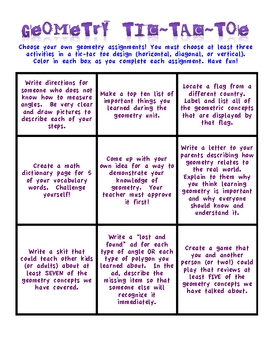The teacher will be aware of student’s individual differences and implement them within content, discussion, and the classroom environment. This will ensure all students, regardless of learning preferences and needs, are able to reach their highest potential. Incorporation and consideration of learning differences when lesson planning and managing the classroom will play a large part in getting students to achieve high standards. Three strategies that can be used to embrace learning differences are differentiated assessments, strategic grouping, and frequent formative assessments.
Embracing Learning Preferences

Teachers can assess students in a way that incorporates and embraces their differences. Offering students a choice in the way that they can “show what they know” allows students to apply learned content in contexts they are familiar, comfortable, and skilled. One worthwhile example of differentiated assessments is a “tic-tac-toe” board with various assessment options. For this example, at the end of any unit, students would choose three activities that go in a row to complete the tic-tac-toe. All of the activities on the board will be relevant and appropriate to the content and will allow for students to utilize a variety of different skills to apply knowledge on any given content area (ex. illustrate, create, exemplify, discuss, write, explain, mind map, present).
any given content area (ex. illustrate, create, exemplify, discuss, write, explain, mind map, present).
Strategic Grouping

When grouping students mindfully, teachers can use knowledge of learner differences to increase the productivity achieved during small group time. Teachers may choose to group students by reading level during word study time so that students can work together doing word sorts and reading level readers. Oppositely, teachers may choose to sort student groups to contain various levels during a small group math project so that students can share various levels and ways of thinking through the same math algorithm. Classrooms will always come with a variety of learning differences – if teachers use their knowledge of these differences to strategically group students, they will see students cooperating and growing with the help of their peers.
Formative Assessments

Using frequent formative assessments is a critical strategy for teachers wanting to use student differences to guide lessons. Not only will do student strategies and preferences for learning differ from each other, but students’ needs and preferences may also change throughout the school year. Using frequent communication, like exit tickets, one-on-one meetings, emails and calls home to parents, and formative interviews with students in class will ensure the teacher has plenty of evidence on their class’s learning differences. Keeping updated on these differences will allow the teacher to consider the needs of students when planning instruction.
